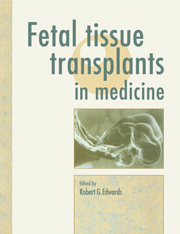Book contents
- Frontmatter
- Contents
- List of contributors
- Preface
- 1 Differentiation and transplantation of embryonic cells in mammals
- 2 Organogenesis and central nervous system development
- 3 Experimental human hematopoiesis in immunodeficient SCID mice engrafted with fetal blood-forming organs
- 4 Ontogeny of human T- and B-cell immunity
- 5 The procurement of human fetal tissues for clinical transplantation. Practice and problems
- 6 Transplantation of fetal haemopoietic and lymphopoietic cells in humans, with special reference to in utero transplantation
- 7 The biology of fetal brain tissue grafts: from mouse to man
- 8 Clinical results of transplanting fetal pancreas
- 9 The suitability of fetal and infantile donors for corneal transplantation
- 10 Transplantation of ovaries and testes
- 11 Cell grafting and gene therapy in metabolic diseases
- 12 The low temperature preservation of fetal cells
- 13 Law and ethics of transplanting fetal tissue
- Appendix: Code of practice on the use of fetuses and fetal material in research and treatment
- Brief bibliography on various aspects of transplanting fetal 337 tissue
- Index
8 - Clinical results of transplanting fetal pancreas
- Frontmatter
- Contents
- List of contributors
- Preface
- 1 Differentiation and transplantation of embryonic cells in mammals
- 2 Organogenesis and central nervous system development
- 3 Experimental human hematopoiesis in immunodeficient SCID mice engrafted with fetal blood-forming organs
- 4 Ontogeny of human T- and B-cell immunity
- 5 The procurement of human fetal tissues for clinical transplantation. Practice and problems
- 6 Transplantation of fetal haemopoietic and lymphopoietic cells in humans, with special reference to in utero transplantation
- 7 The biology of fetal brain tissue grafts: from mouse to man
- 8 Clinical results of transplanting fetal pancreas
- 9 The suitability of fetal and infantile donors for corneal transplantation
- 10 Transplantation of ovaries and testes
- 11 Cell grafting and gene therapy in metabolic diseases
- 12 The low temperature preservation of fetal cells
- 13 Law and ethics of transplanting fetal tissue
- Appendix: Code of practice on the use of fetuses and fetal material in research and treatment
- Brief bibliography on various aspects of transplanting fetal 337 tissue
- Index
Summary
THE IDEA OF TRANSPLANTING HUMAN FETAL PANCREAS into diabetic humans in order to normalize blood glucose levels was first seriously entertained in 1977, when the initial use of the vascularized pancreas (Sutherland, 1981) and the islet (Najarian et al,1975) proved to be unsuccessful. What prompted the move in this direction were the elegant studies of Brown and his group in California, demonstrating that the rat fetal pancreas, when isografted at 17 days gestation into an adult diabetic recipient, was capable of normalizing the blood glucose levels within 4-6 weeks of transplantation (Brown et al, 1974). Subsequent studies by Mandel in Melbourne, Australia, showed that the fetal mouse pancreas behaved in a similar manner when isografted (Mandel, 1984). Several years later, in 1985, the human fetal pancreas was shown to be capable of reversing diabetes when xenografted in the immunoincompetent athymic, or nude, mouse (Tuch et al, 1985b). This and other studies demonstrated that human fetal pancreatic explants, when grafted into these animals, reversed diabetes within one to three months (Hullett et al, 1987; Tuch et al, 19886) (Figure 8.1). The apparent universal potential of grafted fetal pancreas to reverse diabetes gained further support with the demonstration, in 1988, of the successful normalization of blood glucose levels in the athymic mouse by explants of pig fetal pancreas (Walthall et al, 1988) and, in 1990, proislets, or islet-like cell clusters, of this tissue (Simeonovic et al, 1990; Korsgren et al, 1991).
In the Western world, human fetal pancreas is obtained from termination of pregnancies performed up to the twenty fourth week of gestation (Jovanovic-Peterson et al, 1988). In some countries, such as Australia, the guidelines are stricter, prohibiting the termination of pregnancies after 20 weeks (National Health & Medical Research Council of Australia Medical Research Ethics Committee, 1983). In the People's Republic of China, where there is a policy of one child per family, termination, which is an accepted form of contraception, may be performed at a relatively late stage of pregnancy, thus making it possible to utilize pancreas obtained in the third trimester (Hu et al, 1985).
- Type
- Chapter
- Information
- Fetal Tissue Transplants in Medicine , pp. 215 - 238Publisher: Cambridge University PressPrint publication year: 1992



